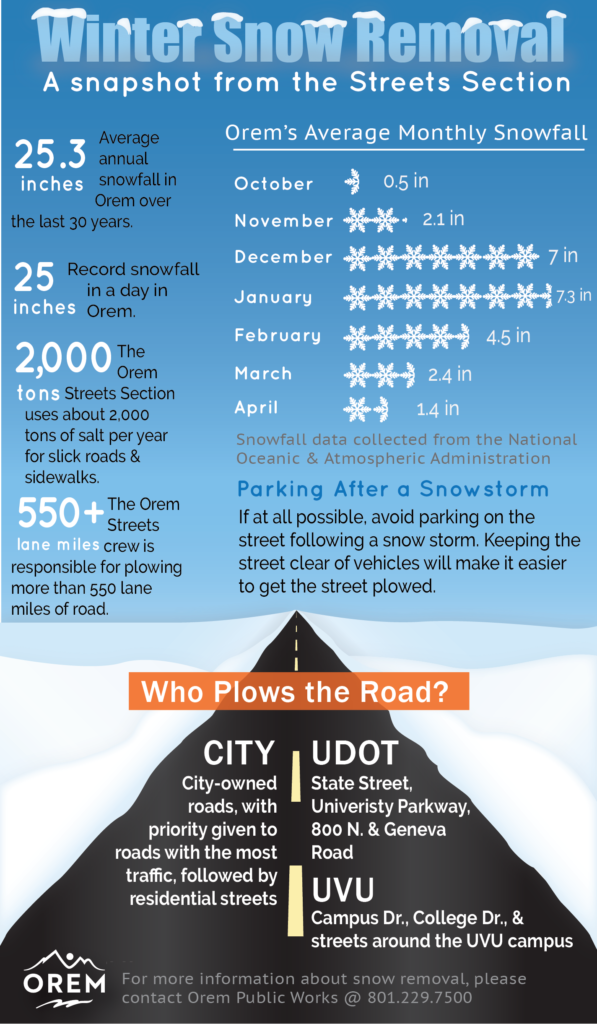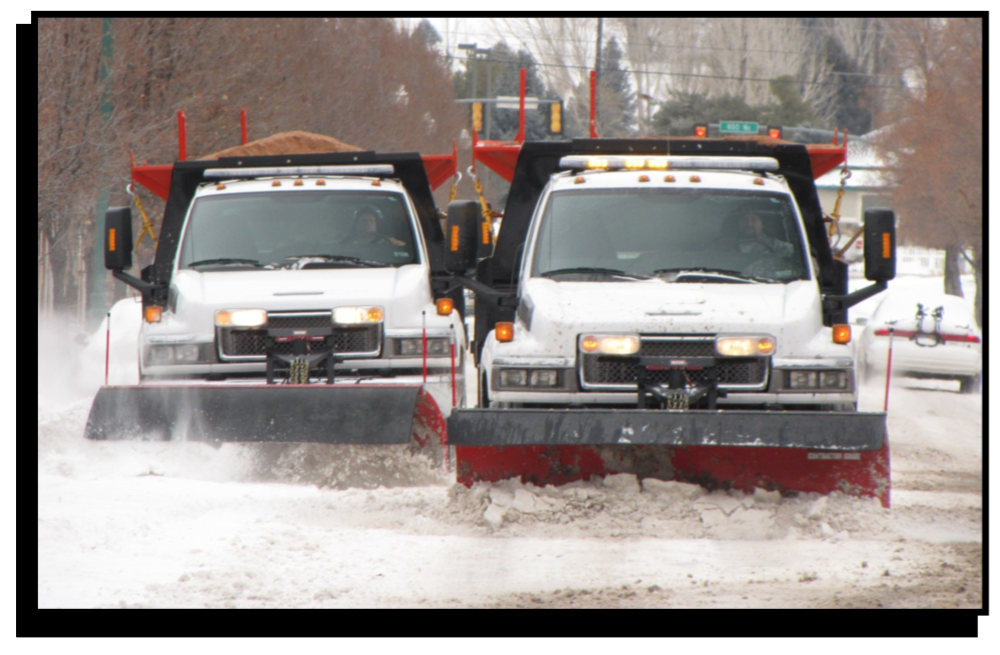With 529 lane-miles of roadway to plow, the Orem Snow Patrol has to have a plan to ensure the safe and orderly movement of critical service & regular traffic.
Orem Snow & Ice Control Plan Goals
- Have all designated streets in the Snow Removal Plan plowed and/or salted within 24 hours after a storm
- Reduce the cost of snow removal through the acquisition and utilization of efficient equipment and proper salt usage
- Divide the City into areas where one truck equipped with a plow and salt spreader can effectively provide snow removal services
- Divide crews and efficiently utilize the assigned personnel to ensure effective snow removal
- Have a sufficient number of trained staff to operate all available snow removal equipment
Frequently Asked Questions
This is one of the most common questions received at Public Works and most of the time we find it is because of one of the following reasons:
Is this street maintained by Orem?
We commonly find these inquiries tend to be roads within Orem’s boundaries, however, they are not maintained for the following reasons:
- Orem does not maintain UDOT owned roads. Roads owned & maintained by Utah Department of Transportation (UDOT): State Street, 800 North, University Parkway, and Geneva Road Please send your comments to UDOT at (801) 227-8000
- Orem does not maintain Utah Valley University (UVU) owned roads. 1200 West from 800 South to Sandhill Road, Roads around UVU.
- Orem does not maintain roads in Private Residential Developments (PRD), Commercial, or Industrial Developments.
Please review map identifying these areas.
Was there room for a Plow and Salt spreading unit to maneuver on this road?
 Often, we are called back to a road, cul-de-sac, or dead end to find there are too many cars parked on the street for the unit to maneuver safely. Our operators have the authority to make safety decisions. If you find there are cars parked along the road, contact your neighbors and ask them to move their vehicles so the snow plows can safely operate.
Often, we are called back to a road, cul-de-sac, or dead end to find there are too many cars parked on the street for the unit to maneuver safely. Our operators have the authority to make safety decisions. If you find there are cars parked along the road, contact your neighbors and ask them to move their vehicles so the snow plows can safely operate.
Is the road compacted and covered with ice?
Our crews try to respond to each storm as quickly as possible, however sometimes traffic compacts the snow and low temperatures cause a layer of ice to form on the road before we can get there. Because our plows are gravity weighted, they are not capable of applying down pressure to peel ice up. Once the ice has formed, the only thing we can do is remove the new snow accumulation, apply salt, and wait for mother nature to help melt the ice. This could take several days.
For a resident this can be quite annoying, but unfortunately it cannot be helped. The snow must be removed from the travelled portion of the road. When the City receives a heavy snowfall, plows have to continue to make several passes until the roadway is safe to travel. This causes snow buildup along the edge of the roadway.

During regular scheduled working hours, the Public Works Department, with assistance from the Police, will monitor street conditions and be responsible for analyzing street conditions and determining when to begin snow removal. During off-duty hours, Public Safety and the Streets Field Supervisor will monitor street conditions. When snow starts to accumulate upon roadways, the Streets Field Supervisor will dispatch units in the affected areas. These units will stay working until all work is completed. If the work takes longer than 12 hours to complete new operators will be called out. Dispatching units quickly is the key to a successful snow removal operation.
The City must remove the snow from the travelled portion of the road. The plow operator cannot push the snow away from the parked cars into the oncoming traffic. That would create a hazard and liability. Snow is always pushed away from the oncoming traffic towards the gutter. When heavy snowfalls are predicted, residents are asked not to park on the roads. Keeping cars off the street will help reduce the chance of plowing in parked vehicles. This minimizes the chance of damaging vehicles and allow for a more efficient plowing operation.
Call 911 if you have a medical, fire, or police emergency. Under their direction it is our first priority to provide access to emergency sites for medical, fire, or police response.
The abutting property owner is responsible to clean the wheelchair ramp up to the edge of the pavement.
You can assist in our snow removal operations in several ways…
- Always park your vehicle off the street. Vehicles left in the roadway create unnecessary obstacles for snow removal operators to work around and can slow the process of properly clearing the road.
- Travel at a safe distance from snowplows at all times to avoid damage to your car. Do not try to pass these vehicles.
- Please be patient if you are required to wait behind a piece of snow removal equipment.
- Make certain that your speed is reasonable for conditions.
- Advise your children to never play near or in a snow berm near the roadway.
- Exercise extreme care and caution when driving in adverse and inclement weather. Your safety and the safety of other motorists and pedestrians is the highest priority!
- Limit and restrict travel unless absolutely necessary during severe weather. Remember, in most cases roads will be cleared and safer within 24 hours of a storm.
- Do not attempt to stop a snow removal vehicle or obstruct its path.
- If you can, please help your neighbors who are elderly or disabled by shoveling their sidewalks and driveway.
- Keep obstructions such as portable basketball hoops, trashcans, and toys off the street and sidewalks at all time during snow removal.
- Please Buckle Up For Safety.
Street Priorities
Orem streets are assigned a priority number for snow removal. This priority number is primarily based on traffic volume, but also takes into consideration other factors including steep hills, emergency services, schools, commercial, industrial, and residential use. The priority determines the order snow removal is carried out.
Priority 1
These streets consist of high traffic volume (arterials), steep hills, and streets serving hospitals, fire stations, police stations, and schools. These streets makeup the minimum network which must be kept open to provide basic transportation.
Examples: Center St., 800 E., 400 N., Orem Blvd.
Priority 2
These streets consist of residential collector streets (secondaries), bus routes, commercial or industrial areas, and streets with a moderate incline.
Examples: 1000 E., Timpanogos Prkwy, 500 W.
Priority 3
These streets consist of residential subdivisions and all other streets not classified as priority 1 or 2.
Examples: 620 S., 310. N, 1160 W.
Monitoring Snow Storms
Monitoring road conditions can be very challenging because of the unique storm patterns that can pass through Orem’s boundaries. The Streets/Storm Water section takes advantage of the traffic camera system in place to help with this effort. Several key areas are monitored through a live video stream loop to help determine appropriate locations to dispatch units.
Weather monitoring is done both online and with the help of local television forecasts. When a storm is in the forecast, preparations are made to make sure all equipment is ready for dispatch. Throughout a storm event, observations of both satellite and radar loops from online resources are monitored to get a better indication of what impact the storm may have.

